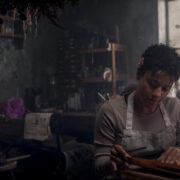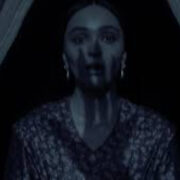BAD EDUCATION’s Portrait Of Altruistic Fraud
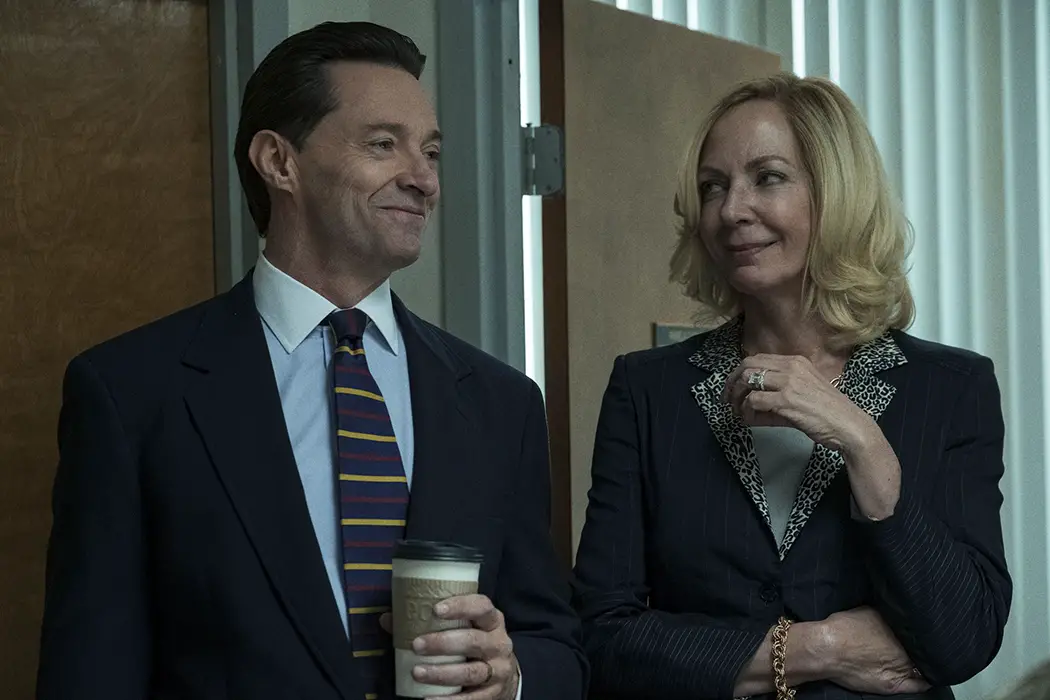
I used to work in politics but film has always…
Bad Education, Corey Finley’s new film about corrupt school administrators starring Hugh Jackman and Allison Janney, is a refreshingly urgent and fascinating character study. Its portrait of greed and fraud in a well-to-do Long Island school district is a prescient reminder to not take for granted the goodness of people in power, as well as the importance of critical journalism. As a study of Jackman’s Frank Tassone, and on the corrosive effects of repression and self-denial, it opens up a portal into one of the most fascinating and terrifying cinematic characters in many years.
In terms of plot, Bad Education is a confluence of two narrative trajectories and the characters who ignite them. On first watch, the film feels more plot-heavy than it actually is, thanks to investigative, procedural elements bookended by very specific plot points. But in reality, the plot is simple, involving careless uses of school district funds, an escalating school paper investigation into the school’s finances, and Frank Tassone’s fling with a former student. When Allison Janney’s Pam, the assistant school superintendent, is fired for letting her son use the district credit card to shop for home improvement supplies, the problem appears to be mostly solved. That is until Rachel (Geraldine Viswanathan, a star in the making), a staff writer for the school newspaper, encouraged in typical fashion by Frank Tassone himself, begins investigating the school district’s finances in regards to an upcoming construction project.
Finley’s Captivating Character Study
The film’s more interesting, character-heavy moments explore the reasons Frank is the way he is, and how he is the unwitting mastermind of his own downfall. Frank’s insecurities betray him as an extremely repressed man, as well as a morally contorted one. Jackman’s Frank Tassone is personable, dedicated, committed to improving students’ lives; but underneath these altruistic pretenses are vast amounts of greed. After all, as Frank points out late in the film to the head of his school board (Ray Romano), you don’t get into education for the money. The portrayal is sinisterly convincing. Jackman’s real-life reputation as one of the nicest men in Hollywood makes him the perfect vessel for Frank, whose own genuine concern for his students not only protected him from suspicion but also aided his crimes.
Finley methodically characterizes Tassone from scratch, even hiding the character’s face from the audience until the very end of the film’s opening sequence, so that we can’t see what he is thinking before he emerges on a stage to the rapturous applause of hundreds of students and faculty. From there, Frank’s persona is laid out with extreme precision. He is a man tortured by insecurities and preoccupied with appearances. He has a carefully molded visage that reflects his environment. It’s a defense mechanism as well as a weapon, one that he uses to woo parents and faculty as well as convince himself of his own place within his world. His charcoal-infused smoothies are a defense against his not-improminent belly that pushes against his sharply pressed shirts and jackets; his hair is perfectly coiffed until Kyle, a former English student he runs into at a Las Vegas education conference seductively pushes it out of place in his hotel; his plastic surgery scars are no doubt a clue as to the ravages of time and the effects of hiding a 33-year marriage to a man from his friends and colleagues; it’s only Frank’s misfortune that they are also the subject of office gossip.
That charcoal-infused smoothie, the humorous bane of Frank’s existence early on in the film is an aptly morbid metaphor for a lot of Frank’s behavior. That it coats his teeth whenever he drinks it in a nearly imperceptible film of black is a subtle reminder that your true self is never buried, never swallowed, always peering below the surface, no matter how impeccably manicured it may be.
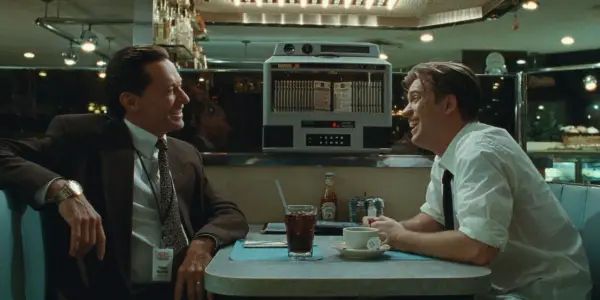
Frank’s grey areas are so vividly realized in Bad Education. It’s one thing to obsess about self-image, it is another to be tortured by the fact that your true self competes with that image. It starts when he uses his famously detailed knowledge of every member of the Roslyn School District to encourage Rachel to expand her story for the school paper. It ends, however, in a genuinely moving scene at a Las Vegas gay bar where, aided by one of the film’s few uses of lush color, the propulsive beats of Moby’s “In This World,” and temporarily free from scrutiny over Rachel’s now published investigation revealing the full extent of his crimes, he slowly sheds his inhibitions and dances with Kyle, finally able to be himself.
Where these grey areas become sinister, however, is where Jackman’s performance shines through. The first time this happens is early on when he has to fire Pam. If you’re totally unfamiliar with this real-life story, the firing reads as a mix of sincerity and coldness; Frank is quiet, careful with his words, but he also can’t look Pam in the eyes. If you are familiar, or you’re watching for the second time, this scene takes on new meaning as the ultimate, but necessary, betrayal.
Another memorable scene happens towards the end. Quickly burning through his goodwill at the school, Frank is confronted in his office by a mother and son we first saw at the beginning of the film in his office in a moment of panic the morning Rachel’s investigation is published in the school paper. The pair are there to ask for his recommendation so the son can join an accelerated learning program, the entrance exam for which the son failed twice. In his anxious fury, spurred by his regret over helping the wrong student and his rapidly disintegrating career, he lashes out at the mother and son in a shocking fit of rage. It’s another brilliant example of Frank’s walls coming down, only this time showing the side of him that was at odds with his public persona for years.
Contextualizing Frank Tassone
Where Frank’s corruption fits into the world at large is complicated, precisely because he is an immensely complicated character. It is perhaps cliché to find connections to Trump in every piece of popular art today, but where it is relevant to contrast one fraud to another, it is useful to do so, if only to illustrate the different ways similar bents of corruption can manifest and destroy lives. That’s why the portrait of Frank Tassone in Bad Education is such an interesting and prescient one; he represents greed that, without constant vigilance, can and will go unnoticed.
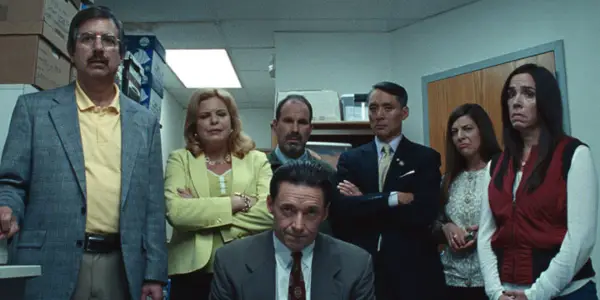
People in positions of power require constant vigilance. That lack of vigilance is why Frank was able to commit his crimes for so long without anyone noticing; it’s also why he was the architect of his own downfall. Yes, Rachel wrote the story that took him down, but it’s not unfair to assume she wouldn’t have written it without his encouragement; Rachel says that the real articles are given to the Seniors. Without anyone looking for trouble, the only person that could have taken Frank down was himself.
Why hasn’t that happened with a figure like Donald Trump, a man with far less public goodwill and a dearth of compassion for the public? Certainly, his election and scarily probable reelection can be traced to the same lack of oversight that allowed Frank to skirt suspicion, yet Trump is in no danger of suddenly outing himself because he’s done it from the start; the forces fighting against him are just powerless to do anything about it.
Bad Education presents the ideal scenario in which the press not only speaks truth to power but wields that power over its abuser; a world in which the press can take down even the most implicitly trusted of public figures. The court of public opinion can only do so much insofar as it mobilizes people at the polls or implores them to open their wallets. But if power-checking institutions are ineffective against even blatant corruption, then the public is a nonstarter.
Frank Tassone’s downfall is the ultimate tragic irony for a man so preoccupied with hiding his true identity that in a moment, no doubt one of many, the supposed “real him” comes out by helping a promising student, he becomes the catalyst for his own demise. It is also the precise reason Frank Tassone, anchored by Jackman’s performance, by far one of the best in his career, is not only one of the most exciting cinematic characters in many years, but the most theatrical and poetic, as if Shakespeare conjured the events himself. He is a reminder that when public leaders show you who they really are, believe them.
What are your thoughts on Bad Education?
Watch Bad Education
Does content like this matter to you?
Become a Member and support film journalism. Unlock access to all of Film Inquiry`s great articles. Join a community of like-minded readers who are passionate about cinema - get access to our private members Network, give back to independent filmmakers, and more.
I used to work in politics but film has always called to me. Now I'm putting my love of the art form to use! I love social thrillers, coming-of-age tearjerkers, and pitch black comedies. The Coen Brothers, Olivier Assayas, Ingmar Bergman, Kelly Reichardt, and Andrew Haigh speak to me on a spiritual level. Enjoy!


